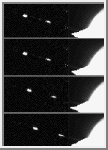|
COMETS EARTH JUPITER KUIPER BELT MARS MERCURY METEORITES NEPTUNE OORT CLOUD PLUTO SATURN SOLAR SYSTEM SPACE SUN URANUS VENUS ORDER PRINTS
PHOTO CATEGORIES SCIENCEVIEWS AMERICAN INDIAN AMPHIBIANS BIRDS BUGS FINE ART FOSSILS THE ISLANDS HISTORICAL PHOTOS MAMMALS OTHER PARKS PLANTS RELIGIOUS REPTILES SCIENCEVIEWS PRINTS
|
Related Document
Download Options
This four-picture sequence (spanning 30 minutes) shows one of four new moons discovered by the Hubble Space Telescope, in images taken of Saturn on May 22, 1995, when Saturn's rings were tilted edge-on to Earth. Identified as S/1995 S3, the moon appears as an elongated white spot near the center of each image. The new moon lies just outside Saturn's outermost "F" ring and is no bigger than about 15 miles across. The brighter object to the left is the moon Epimetheus, which was discovered during the ring-plane crossing of 1966. Both moons change position from frame to frame because they are orbiting the planet. Saturn appears as a bright white disk at far right, and the edge-on rings extend diagonally to the upper left. To the left of the vertical line, each image has been processed to remove residual light from the rings and accentuate any faint satellites orbiting near the rings. The long observing times necessary to detect the faint satellites have resulted in Saturn's bright, overexposed appearance. Saturn ring plane crossings happen only once every 15 years, and historically have given astronomers an opportunity to discover new satellites that are normally lost in the glare of the planet's bright ring system. Credits: Amanda S. Bosh (Lowell Observatory), Andrew S. Rivkin (Lowell Observatory and University of Arizona/Lunar Planetary Lab), High Speed Photometer Instrument Definition Team (R.C. Bless, PI), and NASA. |
